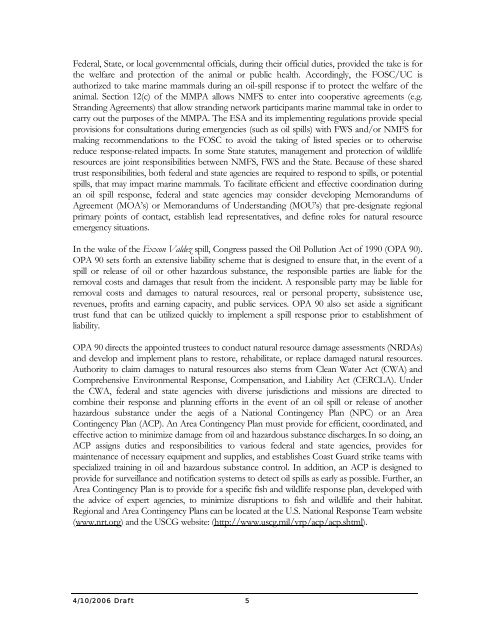Volume III, Appendices EM - National Marine Fisheries Service ...
Volume III, Appendices EM - National Marine Fisheries Service ...
Volume III, Appendices EM - National Marine Fisheries Service ...
Create successful ePaper yourself
Turn your PDF publications into a flip-book with our unique Google optimized e-Paper software.
Federal, State, or local governmental officials, during their official duties, provided the take is for<br />
the welfare and protection of the animal or public health. Accordingly, the FOSC/UC is<br />
authorized to take marine mammals during an oil-spill response if to protect the welfare of the<br />
animal. Section 12(c) of the MMPA allows NMFS to enter into cooperative agreements (e.g.<br />
Stranding Agreements) that allow stranding network participants marine mammal take in order to<br />
carry out the purposes of the MMPA. The ESA and its implementing regulations provide special<br />
provisions for consultations during emergencies (such as oil spills) with FWS and/or NMFS for<br />
making recommendations to the FOSC to avoid the taking of listed species or to otherwise<br />
reduce response-related impacts. In some State statutes, management and protection of wildlife<br />
resources are joint responsibilities between NMFS, FWS and the State. Because of these shared<br />
trust responsibilities, both federal and state agencies are required to respond to spills, or potential<br />
spills, that may impact marine mammals. To facilitate efficient and effective coordination during<br />
an oil spill response, federal and state agencies may consider developing Memorandums of<br />
Agreement (MOA’s) or Memorandums of Understanding (MOU’s) that pre-designate regional<br />
primary points of contact, establish lead representatives, and define roles for natural resource<br />
emergency situations.<br />
In the wake of the Exxon Valdez spill, Congress passed the Oil Pollution Act of 1990 (OPA 90).<br />
OPA 90 sets forth an extensive liability scheme that is designed to ensure that, in the event of a<br />
spill or release of oil or other hazardous substance, the responsible parties are liable for the<br />
removal costs and damages that result from the incident. A responsible party may be liable for<br />
removal costs and damages to natural resources, real or personal property, subsistence use,<br />
revenues, profits and earning capacity, and public services. OPA 90 also set aside a significant<br />
trust fund that can be utilized quickly to implement a spill response prior to establishment of<br />
liability.<br />
OPA 90 directs the appointed trustees to conduct natural resource damage assessments (NRDAs)<br />
and develop and implement plans to restore, rehabilitate, or replace damaged natural resources.<br />
Authority to claim damages to natural resources also stems from Clean Water Act (CWA) and<br />
Comprehensive Environmental Response, Compensation, and Liability Act (CERCLA). Under<br />
the CWA, federal and state agencies with diverse jurisdictions and missions are directed to<br />
combine their response and planning efforts in the event of an oil spill or release of another<br />
hazardous substance under the aegis of a <strong>National</strong> Contingency Plan (NPC) or an Area<br />
Contingency Plan (ACP). An Area Contingency Plan must provide for efficient, coordinated, and<br />
effective action to minimize damage from oil and hazardous substance discharges. In so doing, an<br />
ACP assigns duties and responsibilities to various federal and state agencies, provides for<br />
maintenance of necessary equipment and supplies, and establishes Coast Guard strike teams with<br />
specialized training in oil and hazardous substance control. In addition, an ACP is designed to<br />
provide for surveillance and notification systems to detect oil spills as early as possible. Further, an<br />
Area Contingency Plan is to provide for a specific fish and wildlife response plan, developed with<br />
the advice of expert agencies, to minimize disruptions to fish and wildlife and their habitat.<br />
Regional and Area Contingency Plans can be located at the U.S. <strong>National</strong> Response Team website<br />
(www.nrt.org) and the USCG website: (http://www.uscg.mil/vrp/acp/acp.shtml).<br />
4/10/2006 Draf t 5
















